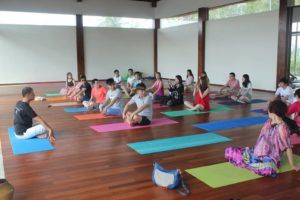What Every Yoga Teacher Trainee Should Understand
Yoga Teacher Training is amazing in that it does not matter how much a student learns, has experience in teaching, or hours of practice — new teachers always open up different perspectives that go on to deepen your understanding of yoga. During the course of any teacher training, you learn quite a few important aspects.
Keep in mind that anatomy and alignment will differ for every single person. Listen to your teacher, but also remember to pay attention to your body. You might chance upon this while perfecting the alignment of some basic poses in a group session. You will discover how completely diverse every single person’s body is — even with similar basic poses. Some people may find it easy to open their hips and hamstrings for a full split while others, might find it tedious, taking days to perform. Those with tighter hamstrings might find it more comfortable to start a downward dog pose with feet placed wider than mere hips-distance apart. If something feels painful, don’t hesitate to back off, speak to your teacher and see if there is a more accessible way to perform the asana.
Yoga classes are great in imparting a lot of knowledge, but it is also essential that you give your body and mind what they need. Practicing at home, allows you to take the necessary time out to do whatever you need, and you can choose to take up something different every single day if you wish to. Taking the time to figure out your needs— distinct from the collective exuberance of a class or being motivated by a trainer— can be really transforming. Utilize the me time to tune in to what’s happening to your inner self.
No one in the yoga world is an outright expert. In fact, the most important lesson for becoming a yoga teacher is the ability to admit, “I don’t know.” On the other hand, one should enjoy the privilege of learning history from those well versed in yoga history and philosophy, a tradition that has influenced Hindu, Buddhist and Jain cultures. Be wary of a few misleading rumors and conceptions that has spread over centuries. Do not hesitate to ask your teacher the basis of their information and do some research on your own. Important historical or philosophical information has a way of changing, becoming confusing or being subject to misinterpretation by mistake.
While a bit of physical adjustment by a teacher can transform a student’s pose and lead to a deeper understanding, it is possible that it may also stir up some intimacy or emotional issues. This makes it important for the teacher and student to approach the development with compassion. Be aware that not all adjustments are equal. Teachers may not always know in details about their students and their experiences. It’s better to let your teacher know if touching makes you uncomfortable. Accordingly, those planning to take up teaching should approach every student with sensitivity, observing their energy and working with them to create an empowering outcome.


